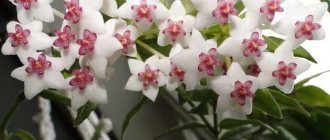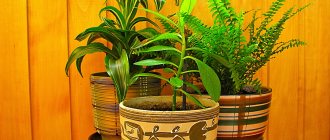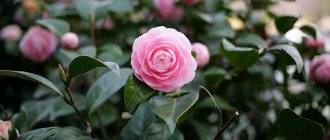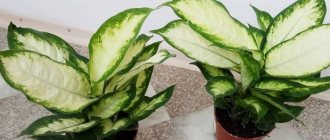In the araceae family there are many plants with an unusual appearance, but among them alocasia stands out for its unique shape and texture of foliage. This is her main pride - large green quilted leaves with carved or wavy edges, similar to a wounded heart. There is another curious feature of the plant - it cries bitter tears due to overwatering or when the humidity is above 80%. Don’t believe the crying - the plant hides poison in itself!
The rare leaves of alocasia awaken the imagination, which is reflected in its popular names - “elephant ear”, “weather plant” and “shamrock”.
Rain scent
Plants report impending bad weather in different ways. Some close the buds so that the moisture does not wash away the pollen formed in them, others begin to cry, sensing that the sun will soon disappear behind the clouds. But most flowers begin to emit a strong aroma a few hours before it rains.
This is especially true for garden flowers: if roses or lilacs begin to smell especially strongly, it means it’s time for people to seek shelter from the weather.
Trees can also use their scent to warn of upcoming rain. Birch begins to smell stronger.
Acacia and Robinia flowers also emit a strong aroma. The latest plants make it especially easy to determine the upcoming weather. When clouds approach, the trees turn into a small buzzing swarm, as the sweetish smell attracts many insects.
How to properly care?
Many gardeners today are interested in indoor alocasia. Home care is quite easy to provide. You just need to create conditions favorable for growing. One of the most important parameters is temperature. In winter, the flower should be kept at 18-20 degrees, and in summer – at 22-26. You need to make sure that the flower does not stand in a draft. As for humidity, alocasia is quite demanding here. In winter, it cannot be sprayed. In summer, the crop requires frequent watering. It is also recommended to regularly wipe the flower with a damp cloth. Flower growers advise placing the container with the plant on wet pebbles so that it does not touch the water.
Smart weed barometers
The general belief that weeds can only cause harm is not entirely true. Some of these plants have the unique ability to notify about imminent rain. And they do this in completely different ways.
For example, a dandelion, which causes a lot of trouble for gardeners with its vitality, closes tightly long before the first drops of rain. The plant anticipates bad weather 8 hours before precipitation. If the sun is shining in the sky, and a yellow meadow covered with dandelions suddenly changes color to green, there is bound to be rain.
Chickweed also indicates upcoming rain in almost the same way. There is only one difference: it does not open its flowers at all in the morning if bad weather is expected.
Another plant - mullein - tilts its stem in different directions of the world, thereby accurately showing the weather for the day. If the inflorescence leans towards the east, it means the sun will shine all day. An opposite slope indicates that it will be cloudy. It is not for nothing that in Germany this plant was nicknamed “meteorological candle” for its talents.
Signs about the flower - female happiness for men
There is a superstition that if a man gives spathiphyllum, he is showing his feelings. Through the state of the plant, you can check the feelings of the chosen one. If spathiphyllum buds begin to fade, female interest weakens. Long flowering indicates love on the part of the chosen one.
Attention! Signs say that the spathiphyllum flower is male and female happiness.
However, the plant is more suitable for women. Male fidelity and happiness - anthurium. These plants are in harmony, complementing each other (like yin and yang).
Room predictors
The weather outside the window has no effect on indoor plants, however, these little helpers can warn of impending bad weather. The green settler contains a genetic memory that causes some plants to perform certain actions, even if bad weather does not directly affect them.
The most accurate indoor predictor is Monstera. The plant, originally from the tropical jungle, has amazing sensitivity to bad weather. Anticipating worsening weather, it begins to “cry,” even if the sun is shining brightly outside the window at the moment. If large water drops form on the beautiful carved leaves, it means that you must take an umbrella for your upcoming walk.
Liquid begins to accumulate on tropical alocasia when bad weather approaches. In this way, the plant gets rid of excess water if the humidity in the air increases before rain. However, excessive watering or high levels of indoor humidity can also cause a similar phenomenon, so this “green forecaster” may be wrong.
It would seem that it is “women’s happiness”, which means it should not cry, but for some reason droplets of water appear on the tips of the leaves of this plant. You may have heard about the weeping willow, about the monster that drives out tears before the rain, or about “widow’s tears,” but for the spathiphyllum to cry, this seems unusual to you, in which case the question arises - why does the flower of female happiness cry?
In fact, guttation (this is the name given to the process by which a plant removes moisture) is a very common phenomenon in botany. In nature, guttation occurs with plants growing in tropical forests; under room conditions, these tropical plants can also secrete water, this is due to high humidity and lack of light. Simply put, a flower begins to “cry” if its roots absorb more water than the leaves can evaporate. By the way, under natural conditions, secretions during guttation are often confused with dew - water vapor that has settled on the flowers and arises due to the coolness. So, as you see, the reason why the flower of female happiness cries is very prosaic.
You can learn more about all the signs and habits of this flower by visiting and reading the information on it.
Plants, including spathiphyllum, have special hydathodes, also called water stomata. These are special pores through which leaves, under the influence of root pressure, begin to release droplets of moisture. Typically, the release of water is observed at night, in the autumn. But do not rush to reduce watering for your plant too much; spathiphyllum loves high humidity, and the guttation process helps it maintain water balance. However, do not overfill!
Many people are interested not only in why the flower of female happiness cries, but also whether its “tears” are poisonous. We dare to assure you that there is no reason for concern, these droplets do not have any toxic substances and they are not dangerous at all, your plant produces ordinary water, only slightly enriched with minerals that are taken from the plant itself (various salts, calcium, etc.) .
If you think that the reason why she cries is connected with some negative aspects: improper care, or maybe with a belief that predicts bad news, then you are mistaken. Guttation is a common process characteristic of tropical plants, and your spathiphyllum flower, don’t forget, originated from such places. Continue to take good care of your flower!
Among the trees and herbaceous plants there are many “weather forecasters” who predict weather changes in a very original way - they “cry”. Moreover, they begin to “cry” in different ways - both a few hours and several days before the rain.
Plant “crying” is a physiological process closely related to water metabolism. When there is a large amount of water in the soil and at high air humidity, when the roots absorb more liquid than can evaporate from the leaves, the excess amount is removed in the form of drops through special holes - hydathodes, usually located along the edges of the leaves. In dry areas this phenomenon is never observed. This process is called guttation
(from the Latin gutta - drop).
Such “crying” of plants can be observed at any time of the year, even in winter. Guttation is most often observed in the early morning, in cloudy, windless weather and before rain. Therefore, the “crying” of plants is a very important synoptic sign, indicating high relative air humidity.
canna - has become widespread in greenhouses.
. It comes from America and East India and can also serve as a barometer, predicting the weather with its “cry”. If transparent droplets of water are found on the wide leaves of the canna in the morning, it will rain in the afternoon.
the cuff is distinguished by its abundant “crying”.
.
Of the aquatic and semi-aquatic plants that “cry” a few hours before the rain, arrowhead
,
chastuha
,
bramble
,
and weeping grass
.
They grow in conditions of constant excess water, so an increase in air humidity inevitably causes a response in them - droplets appear on the tips of the leaves. The same phenomenon can be observed in young oat
.
Among the trees and shrubs that “cry” before the rain, first of all, one should include the willow
.
Before the rain begins, so much water falls from its leaves that the ground under the tree becomes wet. Isn't this where its popular name comes from - weeping willow? Horse chestnut
also warns of rain with its “crying” . He begins to “cry” with sticky “tears” already a day, and sometimes two, before the rain.
Horse chestnut "Baumannii" (Aesculus hippocastanum "Baumannii")
How can guttation water be distinguished from ordinary dew caused by strong cooling of the air at night? You should pay attention to the location of the drops: drops of guttation moisture are usually located on the edges, tips and denticles of the leaves. And dew, formed from the smallest particles of fog, completely covers the entire surface of the leaf with a thin bluish coating or small droplets. In addition, dew does not only form on plants.
Nowadays, everyone is accustomed to using special instruments to determine the weather, but once upon a time, flowers helped our ancestors find out, for example, about the coming rain. However, there are quite a lot of such plants in nature. For example, maples or horse chestnuts “cry” before the rain.
Amazing properties of plants
There are many flowers that can “cry”. By the way, modern science calls this phenomenon guttation (from the Latin “guta” - drop). For example, this is characteristic of the aroid family. These include Dieffenbachia, scindapsus, philodendron and others.
The secret of the weather forecaster flowers
How do plants know when rainfall is approaching? Everything is very simple. Plants always have a lot of moisture. If there is not enough moisture, the plants wither, and subsequently, due to prolonged drought, they dry out. If, on the contrary, there is an excess of moisture in the soil, then some flowers are able to get rid of it in different ways - through their leaves, stems, and inflorescences. Some produce “tears”, others increase the amount of nectar, and still others get rid of excess moisture, enhancing their aroma.
In turn, a few hours before the rain, evaporation always decreases and the ground becomes moist. This may not be noticeable to us, but it is quite enough for plants.
Why do the flowers that grow in the room “cry”? The same principle applies here. When we overwater a certain type of plant, its roots and leaves supply too much moisture, which does not have time to evaporate. As a result, droplets of excess moisture appear at the tips of the leaves.
Although this behavior of houseplants almost never predicts rain, it is still worth paying attention to. After all, it is your pets who are asking you not to flood them so much.
In those days when radio and weather centers did not yet exist, people learned about upcoming bad weather with the help of plants. Many flowers are real weather forecasters: they are able to make a completely reliable weather forecast. Drops of dew and closed flower buds most often indicate that it is going to rain, and lush flowering portends sunny weather.
Feng Shui meaning
According to the teachings of Feng Shui, plants in the house carry a certain energy that directly affects human energy. In alocasia, this energy is arrow-shaped. It moves from top to bottom, then goes up again.
Such a movement will help in any struggle, hard work, in all matters and endeavors that require concentration, significant effort and attention. Therefore, the best location of the plant is an office or next to a workplace in a common room - those places where a person feels the need for increased concentration of his strength, knowledge, and attention.
Alocasia prefers the northern or western direction of a room or apartment - it is there that it can show its properties in full force.
Alocasia is a toxic plant. But by handling it carefully, the grower does not risk anything. But, if you believe the signs, the house, thanks to the plant, will always be protected, and comfort and harmony will always reign inside its walls.
Weather forecast from flowers
While caring for flowering plants, our ancestors noticed that some representatives of the flora are indifferent to weather changes, while others change their behavior depending on the level of humidity. Most often, flowers, which may suffer from heavy rain, or inhabitants of tropical rainforests, whose whole life is connected with water, react to the weather. Both indoor and garden flowers, as well as some trees, can predict the weather; it is only important to know what signs and phenomena to pay attention to.
Different plants have their own prediction period. Some begin to “cry” a few hours before the rain starts, others almost before the downpour, and some even a day before. There are several signs that indicate a change in natural conditions. Some plants close their buds, others intensify their aroma, and others begin to release drops of moisture.
All these phenomena are the result of adaptation to new conditions. Closed petals, tightly pressed to each other, are not easily torn off by gusts of wind and large drops of rain. Increasing the smell is a way to attract insects. They must have time to pollinate the flowers before bad weather. Acacia and honeysuckle smell the strongest before the rain, and the aroma can tell about the imminent arrival of evening. The release of droplets on the leaves is the result of an increase in air humidity, at which normal evaporation of moisture does not occur.
Signs about the flower - female happiness for women
Women like the plant not only because of its pleasant appearance. When choosing a flower to grow at home, they are also guided by positive signs and superstitions. However, in order for good omens to come true, it is necessary to surround the spathiphyllum with care and sufficient attention.
According to superstitions, spathiphyllum strengthens the love between spouses. If a couple inhales the aroma of a plant, jealousy and mistrust are eliminated. Spathiphyllum placed in the bedroom normalizes intimate life and prevents infidelity.
If the spathiphyllum takes on a rounded shape, you can expect an addition to the family. According to signs and superstitions, positive energy strengthens the health of a pregnant woman and facilitates the birth process.
The sign says that female happiness is suitable for cultivation by single girls. They become gentle and charming. Spathiphyllum helps you find your unique style and increase self-esteem.
Monstera and alocasia
It would seem that indoor plants do not care at all about the weather on the other side of the window, but they have retained their genetic memory and continue to predict rain. The most famous home weather forecasters are monstera and alocasia.
The tropical liana monstera evokes far from the best associations for many, but its name goes back not to the word “monster”, but to the Latin monstrosus, which translated means “amazing, bizarre.” The huge carved leaves of the monstera are very beautiful, and the aerial adventitious roots give it a mysterious look. Before the rain, quite large drops appear on the leaves, so if you find that the monstera is crying, do not forget to grab an umbrella.
Alocasia is also native to the tropics. Its leaves with bright veins are located on long stems. There are millions of stomata on the surface of the leaf, through which the flower gets rid of excess moisture. In the homeland of alocasia, there is so much water during the rainy season that the plant had to find a way to dump the excess. So when air humidity rises, which happens before rain, the flower also begins to cry. However, the same effect can also appear if you water too much, so you shouldn’t trust the flower forecaster too much.
Carved heart of tropical swamps
This moisture-loving exotic came to us from the tropical forests of India, Ceylon, and Malaysia. More than 70 species are known, differing in size, shape and shades of foliage. What unites them is the structure of the leaf plate:
- resemblance of outline to a heart or shield;
- a thick vein standing out from the upper and lower sides of the leaf, contrasting its color with the general background;
- uneven edge;
- leathery, dense texture of leaves;
- water stomata (hydrators), through which excess moisture is released.
Mallows and morning glory
The beauty of hollyhocks can compete with many tropical plants: lush buds on tall stems can decorate any garden. Usually hollyhocks are planted in groups: this way they look more attractive. If in the middle of a sunny day you notice that the flowers began to wilt and then completely closed, do not plan a trip to the river or long walks. Mallow flowers close on the eve of bad weather.
Morning glory is an annual climbing plant that is often used for decorative vertical gardening. Bright bells of white, pink, red and blue are buried in the lush green leaves. As a rule, morning glory blooms only in the morning and fades in the light of the sun. On a cloudy day it can last longer, and then the fence or wall of the house will delight you with the magnificent spectacle of hundreds of buds blooming.
As soon as the rain clouds approach, the morning glory folds its petals, so that in the rain the already ripe buds may not open. The property of the plant is quite clear: the petals are too delicate to withstand the pressure of rain streams. In addition, bees and other insects are hiding anyway, so there is no point in the plant expending energy opening the flower.
Magic properties
Various magical properties have long been attributed to the flower.:
- Alocasia, as a living creature, takes root only in a home where it is loved, appreciated and cared for as a member of the family.
- It is believed that this plant is an excellent protector of the biofield of the apartment owners. Therefore, envious guests or ill-wishers are not afraid of those who have alocasia in one of their rooms.
- Alocasia growing in a house can improve the atmosphere in it, and several flowerpots with a flower can even change the character of an angry person living in this room, making him softer and more tolerant.
- The plant will also help cope with the irritability of a family member that appears after a quarrel or other unpleasant event. In general, this flower balances the human psyche, calms the nervous system, normalizes sleep, and does everything possible to make the owners of the flower less susceptible to bad moods.
- According to astrologers, the plant has the most beneficial effect on representatives of the signs of Aquarius and Pisces: alocasia placed in the office of such a person will help him concentrate and increase his productivity.
Tulips and crocuses
Spring primroses have a short lifespan. And in a week or two, crocuses manage to raise their buds to the sun, bloom and bloom. Gardeners have long noticed a peculiarity of tulips: before the onset of rain, their buds close. The shape of the flower resembles a glass. If it had not learned to close, the water would have filled the natural vessel and the stem would have broken. But even if the flower had survived the rain, all the precious pollen would have been washed away and wasted without any benefit. Fortunately, tulips have learned to detect air humidity and predict the weather.
Crocuses and tulips react not only to humidity, but also to temperature. The buds close at the slightest threat of cold weather. With a bed of bulbous plants, it's easy to determine how warm the coming day or night will be. Interestingly, crocuses are divided into autumn and spring varieties. Autumn ones bloom in September, when other bulbous plants have long since faded and fallen asleep. Both spring and autumn varieties can predict the weather.
Photo gallery
`
If alocasia is properly cared for, it develops 6 leaves per year and can reach gigantic sizes (50-80 cm in length). Indeed, why not an elephant's ear!
Dandelions
Some quite nice flowering plants do not have the best reputation among gardeners. Dandelion is considered a weed because it has amazing vitality and ability to reproduce. In addition to light white parachutes, it can also reproduce by root particles, so dandelion thickets have to be weeded several times.
Dandelion is another barometer plant. It is able to accurately predict rain several hours before the first drops fall. In sunny weather, the golden ones are open until the evening. But if you see that the meadow has turned from golden to green, it will soon rain.
Interestingly, it’s not just the dandelion’s flowers that close. The fluffy heads with seeds also know how to curl up so that the fluffs are not washed to the ground by water, and they can fly as far as possible from the parent plant.
Growing conditions
Many gardeners today are interested in how alocasia should grow. Care at home, photos of healthy “pets” in a pot, recommendations from experienced gardeners - these are just some of the popular questions. This crop is a rare deciduous ornamental plant characterized by rather original flowering. It loves warmth, so if you decide to grow alocasia at home, be sure to take this factor into account. In addition, it is necessary to monitor the humidity level.
Answers to frequently asked questions
Why do anthurium leaves curl?
The cause may be a draft, direct undispersed lighting or dry air, because “male happiness” loves a humid climate.
For anthurium to have a beneficial effect on life, does it have to be red?
No, all anthuriums (pink, red, blue) will “serve” equally well if you take care of their health.
Is it possible to place anthurium in the corridor?
There is a superstition that “male happiness” in the corridor will somehow protect the house from unwanted guests: a person who comes into the house with bad intentions will feel bad.
Top dressing
How does the alocasia flower grow? Home care, photos of plants, propagation conditions - all this information is basic for experienced gardeners. In order for alocasia to grow well, it needs to be fed in the warm season. The procedure is performed once every 2-3 weeks. For feeding, you can use complex mineral fertilizers. They are sold in specialized retail outlets.
Watering
What humidity level does alocasia require? Home care involves timely, abundant watering. The crop especially needs moisture in summer. At this time, under no circumstances should the soil be allowed to dry out. It is best to water the plant with soft, settled water. The liquid in the pan should not stagnate; it should be drained after each watering. In summer, it is important to ensure that the pot with alocasia always has moist soil.
In the cold season, the plant should be watered moderately. This procedure must be carried out with utmost care. If there is an excess of moisture in the root system, rotting may occur.
Lighting requirements
Many gardeners are interested in how large-rooted alocasia should grow. Home care requires good lighting. This is a general rule for all tropical flowers: the brighter the leaves, the more light there should be. In this case, the crop must be well protected from the sun. If the foliage of alocasia has a uniform color, then the flower is quite capable of surviving in low light conditions. This culture can be classified as unpretentious. This greatly simplifies the process of caring for the plant at home.











